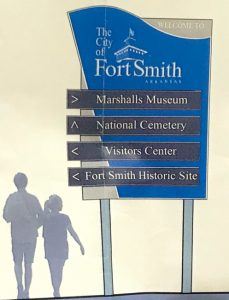Western Arkansas Planning and Development District sets April 2 deadline for wayfinding requests
by February 15, 2018 6:50 pm 890 views

Updated rendering of the planned U.S. Marshals Museum under construction in Fort Smith.
Member cities of the Frontier Metropolitan Planning Organization (MPO) have until April 2 to turn in their signage submissions for a wayfinding program in the Fort Smith region.
Western Arkansas Planning and Development District (WAPDD) Executive Director Sasha Grist told Talk Business & Politics the desire for wayfinding started “two or three years ago,” inspired by a similar program in Northwest Arkansas. From there, WAPDD facilitated a preliminary design plan — created by MAHG Architecture — that was approved by the Arkansas Department of Transportation (ArDOT) in June of 2017. The approval was necessary because it allows communities or clusters of communities to promote community-focused projects on state highways.
The chosen designs will soon be handed off to an engineering firm to create specs, which, along with the quantity of needed signs, will enable requests for competitive bidding.
“We have the plan approved and a price on the signs, but now it’s about, ‘How are we going to get it implemented?,'” Grist said. “When MAHG did the design, they said that due to the scale of it, we should talk to an engineering firm.” WAPDD is considering McClellan, Hawkins-Weir, and Morrison-Shipley Engineers for further development of the specs,” Grist said.
Wayfinding programs are open to vehicular and pedestrian signage, but they must not be used for common advertising, so signs pointing to restaurants and stores, as examples, are prohibited. What these signs can do, however, is point to locations that serve the community as a whole and help with economic development.
Eligible signage examples would include the United States Marshals Museum, University of Arkansas at Fort Smith (UAFS), sports venues, water parks, breweries/wineries, casinos, farmers’ markets, business districts, specialty shopping centers, fairgrounds, concert halls, architectural districts (like Downtown Fort Smith and Chaffee Crossing), Visitors Centers, and historic sites.

Pricing signage options from FSG, Frontier MPO Director Reese Brewer noted that each individual sign ranges from $3,150 for a “parking trailblazer” to $5,800 for a “vehicular directional.” Prices, Grist added, would vary significantly from that based on the quantity of signs ordered, so a clear estimate will not be possible until participating communities return with their requests by the April 2 deadline and WAPDD can submit complete specs.
Cities also may place separate order requests, but that could be cost prohibitive as smaller orders mean larger prices. That said, communities have to balance their needs with their available funds, Grist said, pointing to Fort Smith, the area’s largest city, as an example of a community that “will have to do theirs in phases.”
To assist in paying for the programs, cities can apply for grants through the Transportation Alternatives Program of ArDOT. TAP grants are structured as 80/20 matches, so participating cities will have 20% capital outlay on the overall cost once approved. Grist said these types of grants would be more likely to help with pedestrian-focused signs.
“Signs off the Interstate probably won’t be grant-eligible,” she added.
Grist expects the wayfinding program to be in motion throughout 2018.
